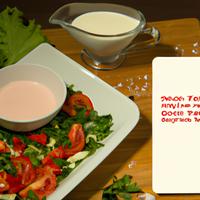
1 serving (100 grams) contains 80 calories, 1.0 grams of protein, 6.0 grams of fat, and 5.0 grams of carbohydrates.

Log this food in SnapCalorie

Nutrition Information
Calories |
190.5 | ||
|---|---|---|---|
% Daily Value* |
|||
| Total Fat | 14.3 g | 18% | |
| Saturated Fat | 2.4 g | 12% | |
| Polyunsaturated Fat | 0 g | ||
| Cholesterol | 0 mg | 0% | |
| Sodium | 357.1 mg | 15% | |
| Total Carbohydrates | 11.9 g | 4% | |
| Dietary Fiber | 2.4 g | 8% | |
| Sugars | 4.8 g | ||
| protein | 2.4 g | 4% | |
| Vitamin D | 0 mcg | 0% | |
| Calcium | 47.6 mg | 3% | |
| Iron | 1.2 mg | 6% | |
| Potassium | 357.1 mg | 7% | |
* Percent Daily Values are based on a 2,000 calorie diet. Your daily values may be higher or lower depending on your calorie needs.
Food Attributes
Source of Calories
About Side salad with dressing
A Side Salad with Dressing is a versatile dish commonly associated with Western cuisine, though variations can be found globally. Typically, it features a medley of fresh greens like lettuce, spinach, or kale, paired with vegetables such as tomatoes, cucumbers, carrots, and onions. Optional additions include croutons, cheese, or seeds. The dressing—ranging from vinaigrettes to creamy options like ranch or Caesar—adds flavor but also impacts nutritional content. Rich in fiber, vitamins, and antioxidants, the salad promotes digestive health and supports overall well-being. However, calorie content can increase significantly with heavier dressings or toppings like cheese and bacon. Opting for lighter dressings or portion control can make this a smart choice for balanced eating. Perfect as a complement to a main course or a quick, refreshing starter, a side salad provides simplicity and nutrition in every bite.



